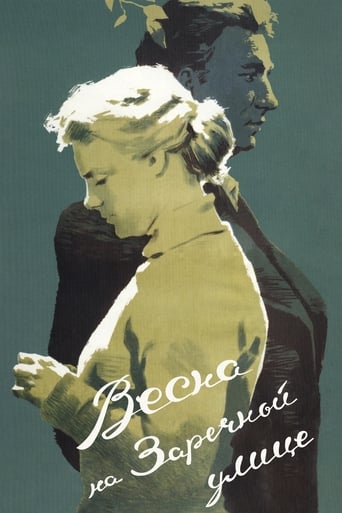



Good start, but then it gets ruined
It's the kind of movie you'll want to see a second time with someone who hasn't seen it yet, to remember what it was like to watch it for the first time.
View MoreA terrific literary drama and character piece that shows how the process of creating art can be seen differently by those doing it and those looking at it from the outside.
View MoreThere are moments that feel comical, some horrific, and some downright inspiring but the tonal shifts hardly matter as the end results come to a film that's perfect for this time.
View MoreSpring on Zarechnaya Street (1956) is a romance following Tatyana, a new Russian literature professor teaching night school to workers, and Sasha Savchenko, a common factory worker that takes a liking to his teacher. Tatyana Sergeyevna precedes the Veronica character in The Cranes are Flying (1957), as they both reclaim the femininity that had been denied to women in socialist realism. The film is part of the Khrushchev Thaw, a period declaring Stalinism illegitimate and restoring the mitigation of Leninism. Cinema during the Khrushchev Thaw privileged the everyday Soviet, rather than the romanticized historical epics that categorized Late Stalinism. Directors Khutsiev and Mirroner literally portray the thaw on screen in the seasonal transition between winter and spring as we hold on puddles of melted ice. While the out of sync audio in the YouTube version compromised the viewing experience and the moment of Sasha's embarrassment in the classroom was lost, as the paragraph on the blackboard is not translated, nevertheless Spring on Zarechnaya Street contains astonishing instances of cinematic beauty. As Sasha arrives at Tatyana's for tutoring, the two are staged facing each other in the frame but are separated on opposite planes. Khutsiev and Mirroner hold on the shot as the piano concert plays over the radio and the audience is able to grasp Sasha's longing for Tatyana. Several images stand out, such as the shallow focus close-up of Tatyana at the end of the dance as the out of focus couples hypnotically spiral around her face and the extreme long shot of Tatyana visiting the factory where she is entangled in the shadows of the overhead cables. The conclusion of the film is handled with remarkable elegance as Sasha opens the window into Tatyana's room causing a gust of wind to make a blizzard of Tatyana's papers.
View MoreI love this movie. I have a copy of it and I can watch it several times a month. I think that every woman (no matter what age) would want to be looked so adoringly at as Rybnikov looks at Ivanova in the last moments of the movie. This is a movie of my childhood and I may not be objective. But the actors are really good in it and sincerity and naivety of the story is just wonderful. Nina Ivanova had a short part in Ryasanov's "Easy Life" (Leghaya Zhisn) where she played the same part of Tatiana Sergeevna by then married to Alexander Savchenko (Rybnikov's part). I wonder how all that came around. May be that question should be directed to Eldar Ryasanov. Does anyone know about Ivanova's life? Is she still alive?
View MoreHi !I recently saw this very old 1956 Soviet film in Russian TV and very much impressed to main roll actress Ms.Nina Ivanova of her beauty and excellent ability to play her roll.Also theme song of this film is lovely and easy to sing.This film might be one of best films of so called "snow melting era" of Soviet Union (after death of Josef Stalin in 1954) where peoples still had huge hope over the future of Soviet Union.Even after collapse of Soviet Union, this film is still shining because of its straight hymn to human life.
View More